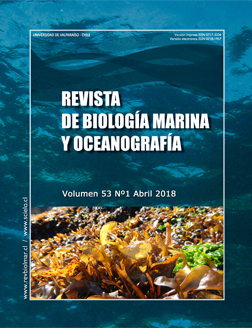Growth and bioremediation capacity of Chlorella vulgaris (Trebouxiophycea, Chlorophyta) cultivated in wastewater generated in the fish farming of the yellowtail amberjack Seriola lalandi (Perciformes: Carangidae)
DOI:
https://doi.org/10.4067/S0718-19572018000100075Keywords:
Microalgae, Chlorella vulgaris, wastewater, growth, removal nutrientAbstract
Growth of microalgae Chlorella vulgaris and its efficiency in dissolved nutrients removal from effluent generated by yellowtail amberjack hatchery production were studied under laboratory scale conditions. This research evaluated indoor and outdoor conditions during 8 days, using filtered and UV light disinfected effluent, inoculated with an initial concentration of 2.06·106 ± 4.16·103 cells mL-1 of Chlorella vulgaris. In the determination of the growth and removal of nutrients, 12 transparent cylindrical-conical ponds with a capacity of 50 L were used. Three ponds were used for each experimental condition, indoor (3) and outdoor (3), with effluent water from the dorado culture, the remaining six ponds were controls using 1μm filtered seawater, disinfected and enriched with general culture medium F/2, in indoor (3) and outdoor (3), respectively. The result of growth under indoor condition reached a maximum value of 4.17·106 ± 7.57·105 cells mL-1 after 6 days. Similar growth was achieved in control tanks 4.75·106 ± 2.29·105 cells mL-1, whereas in outdoor experimental condition the maximum growth obtained was 2.81·106 ± 2.69·105 cells mL-1 reached on day 2, compared with controls that showed a maximum growth of 1.83·107 ± 2.29·105 cells mL-1. The best nutrient removal results recorded as nitrite removal were values of 91.67 and 88.41% (indoor and outdoor conditions, respectively). Nitrate removed reach a 57.47% (indoor) and 29.31% (outdoor) and a similar ammonia removal of 42.22% for both experimental conditions. Finally, high phosphate removal of 65.78% (indoor) and 75.78% (outdoor) were observed. The results show that the use of the microalga Chlorella vulgaris for the absorption of nutrients and growth in wastewater is feasible, which opens up encouraging perspectives for its application in purification processes in the fish farming activity or another industry that generates effluents with these characteristics.
Downloads
Downloads
Published
How to Cite
Issue
Section
License
Copyright (c) 2019 Universidad de Valparaíso, Chile

This work is licensed under a Creative Commons Attribution-NonCommercial 4.0 International License.
• Los autores que publican en la RBMO transfieren sus derechos de publicación a la Universidad de Valparaíso, conservando los derechos de propiedad intelectual para difundir ampliamente el artículo y la revista en cualquier formato.
• La RBMO autoriza el uso de figuras, tablas y extractos breves de su colección de manuscritos, en trabajos científicos y educacionales, siempre que se incluya la fuente de información.





